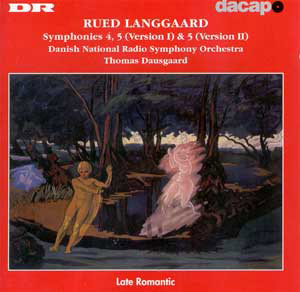This bids fair to be THE cycle for Langgaard enthusiasts.
Dausgaard and Dacapo have set out to provide a definitive edition. It
could easily have been a dull academic affair but not with Dausgaard
at the helm. We must look to Dausgaard as a beaming bright prospect
in the international orchestral stakes.
The Fourth Symphony was the first to put Langgaard
on anyone's map. There was a DMA and then EMI LP of the symphony, coupled,
I seem to recall, with some Lange-Muller. This came out in 1973. It
was the first Langgaard I had heard. That version (was it John Frandsen?)
did not impress me greatly. It was only when a friend lent me some reel-to-reel
tapes of the mid-period symphonies (10-11) that I began to take to Langgaard
with his Schumann-like voluptuously ecstatic cresting sunrises. Dausgaard
gives this work, which ranges over an autumn landscape, a world-beating
performance full of gusty downpours, thunderstorms, sunlight and repose.
The bell-evocation in section 12 is strikingly cold and gaunt - looking
forward to Britten's Grimes. It is staggering to think that this
piece was written during the Great War by a composer still only 23.
Then come two versions of the Fifth Symphony. In fact
four exist. The original was an orchestral fantasia entitled Summer
Legend Drama then came another version with much new material. This
was entitled Symphonic Festival Play.
The two works recorded here are of the later two versions
in which the music emerged as a symphony. The first version of Symphony
No. 5 is based on Summer Legend Drama. That version receives
its world premiere recording here. Once again nature is the stepping
off point. Language partly shaped by Schumann and partly by Wagner makes
for a powerful work. There is even a strong suggestion of Elgar from
time to time. Dausgaard keeps things buzzing along and is forever goading
and pushing forward. He would make a revelatory Bax conductor. Listen
to the solo violin writhing and threading through the soft wailing of
the orchestra. This is utterly original music punctuated with shudders
from Tapiola and from the upheavals of Nielsen's Fourth and Fifth Symphonies.
Quite apart from its originality the musical and emotional effect of
this music is remarkable.
The second version is entitled Steppenatur and
it is this version that you are most likely to have encountered before.
This is very different and I think far less effective than the first
version. The principal weakness is the unrounded and unconvincing ending.
Great Bachian fugal patterns stride through the work with Beethovenian
stompings soon to be transfigured in the Third Symphony of Nielsen.
Other elements include Sibelian chatter, Griegian regret, Mahlerian
ländler (III) and pastoral summer serenading of the type familiar
from Nielsen's Springtime on Fyn.
Superficially this is old-fashioned sounding music
but then so is George Lloyd. Langgaard's triumph is not just that he
takes these sounds and makes of them something highly individual but
also that he has fresh things to do and say in this language.
The notes are by the world authority on Langgaard,
his biographer and cataloguer, Bendt Viinholdt Nielsen. You could not
ask for better annotation and it is a great bonus that Nielsen is not
one of those writers who taxes you with acres of musico-technical description.
His descriptions are always accessible and to the point.
Do try to hear this disc. If you want to sample then
audition tracks 1 and 17.
Rob Barnett
EARLIER ISSUES IN DACAPO'S LANGGAARD SYMPHONY CYCLE
Dausgaard/Danish NRSO
Symphonies 6-8 8.224180
Symphonies 9-11 8.224182
see also Sinfonia Interna Aarhus SO/Frans Rasmussen
8.224136


